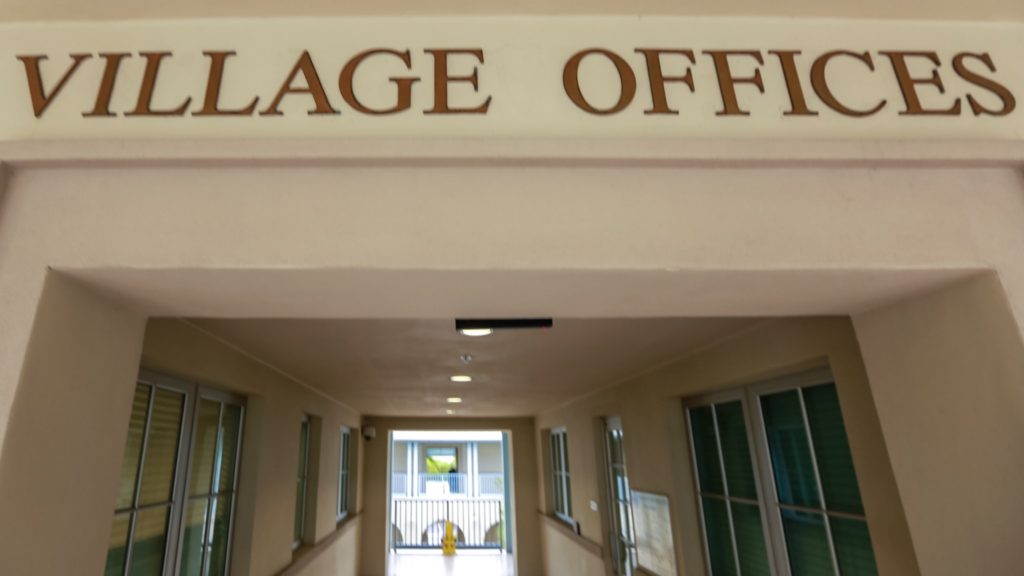Council Keeps Village Taxes Flat as Budget Battle Begins
Tony WintonJune 24, 2019

Entry to administrative offices of the Village of Key Biscayne, June 19, 2019 (Key News/Tony Winton)
A divided Key Biscayne Village Council began the 2020 budget process by keeping property taxes flat in a preliminary vote that pitted advocates of maintaining current programs and employee staffing against those wanting to cut taxes.
The three-hour session Tuesday was the most detailed yet on the Village’s $35 million budget and more than $100 million of possible long-term capital projects, many of them focused on resiliency.
One question: with a dip in property values, can capital projects, popular programs and the existing Village payroll escape unscathed?
Probably not, based on the contentious discussion and a 4-3 vote that, if adhered to, would rule out any tax increase in 2020 and will almost certainly lead to cuts somewhere.
While taxing and spending debates take place in every community, the tension appeared incongruent with Key Biscayne’s status as both one of the lowest-taxed communities in Miami and one of the wealthiest places in the United States.
The U.S. Census bureau reported the island’s median income was $128,563 in 2017, more than double the national average. Incomes on Key Biscayne were up more than 3 percent from the previous year, despite the ongoing decline in property values, a dip some attribute to foreign investment and market corrections.
Despite that continued affluence, fiscal control was the word of the day. The only question seemed to be how much and where to cut.
The Council’s decision involved a required legal notice – called a “TRIM notice” — that is mailed by Miami-Dade County to property owners each August. The law requires local governments to declare a nonbinding tax intention in advance of the budget process. While the rate can be changed in September, by adopting a “rollback rate” of 3.195 mills the Council sent a signal it is not looking to raise taxes. That might prove hard to do with the large number of capital projects identified as priorities by members at its May strategic retreat.
Making the budget tension more acute was a desire by some Council members to reduce taxes. Such a reduction would take place if last year’s property tax rate of 3.1 mills ($3.10 for each $1,000 of taxable value) were to be adopted again.
Mayor Mike Davey asked colleagues to not tie the Village’s hands as it plans for public borrowing to fund resiliency projects such as undergrounding, stormwater enhancements and beach renourishment. If the improvements are funded through a general obligation bond, the borrowing question could appear on the November 2020 ballot.
Council Member Katie Petros asked Village Manager Andrea Agha if she could balance the budget with a tax cut. Agha said she could – but would have to do so by cutting $700,000 in popular community outreach programs and by dropping all capital projects.
Petros ultimately sided with those advocating for tax cuts.
“I think it would send a really nice message to the community” if taxes are cut by adopting the 3.1 mills rate, she said.
Council Member Luis Lauredo agreed, saying when property values dip, Village leaders should follow suit. “We have to live within our means,” he said, adding he only wanted to fund “core” functions.
“I have a difference of opinion with you on that,” said Mayor Davey, who said the Village’s programs are part of what makes Key Biscayne the place it is.
Vice Mayor Allison McCormick voted to hold taxes flat because Agha said she has only just started with her formal budget recommendation. “We need to have the option there if she’s literally only 20 percent through.”
“We don’t have anything in front of us. We just don’t know,” agreed Council Member Brett Moss, who said the Council should decide budget priorities first before making adjustments to the tax rate.
But even if the Council holds taxes flat, it’s possible services and perhaps even staffing levels could see deep cutbacks if the Village adds significant debt service to fund the capital projects.
For example, the proposed $46 million utility undergrounding project would translate to an additional 0.377 mills, according to estimates prepared by the Public Works Department. That project alone would be four times as large as the amount being debated at Tuesday’s workshop, 0.095 mills.
But Petros saw the taxation question as linked to the capital projects. “It will give trust to the community that we can go ask for money for these bigger projects,” she said. “Because we’ve shown that we can control the operating costs.”
No one disagreed.



Responses
Jorge Mendia
Jun 24
Every June, the Village holds its budget workshop and as part of that process sets its TRIM/millage rate. It is always contentious but fairly inconsequential. Almost all homesteaded property owners are completely unaffected by the Village’s millage rate. Our taxes go up by 3% yearly as per state law no matter what the Village does. If the millage rate goes up from 3.1 to 10, we pay an additional 3%. If the millage goes down from 3.1 to 2, we still pay an additional 3%. The only ones that benefit are the investors and non-homesteaded property owners who this year with a roll back millage rate may pay the same as last year. And if the council in September decides to keep the millage rate at 3.1, non-homesteaded properties will see a 3%
decline in taxes while the majority, homesteaded, will get their yearly 3% increase. That is a very significant 6 % differential in tax adjustments. Does not make sense.
With all the plans, hopes and aspirations ahead of us, this is the year to increase the millage rate. Those homesteaded would see no difference at all, the majority. The investors and others would see a marginal rise. A good investment.
The comments are closed.